
Los Angeles School Police Programs
by Ryan Park
Did you know that LAUSD schools have their very own police department? The mission of the Los Angeles School Police Department (LASPD) is to assist teachers, administrators, and other staff in providing a safe environment in which the educational process can take place for the 565,000 students of the district. In addition, they offer multiple programs for community engagement, career opportunities, and safety, some in partnership with the Los Angeles Police Department (LAPD).
LAUSD Police Academy Magnet Schools (PAMS) Program
In this program, students under the guidance and supervision of LAPD and LASPD police instructors are taught to develop life skills through positive interactions with police officers. The life skills that PAMS teaches you are promoting self-esteem, communication skills, and activities for scholastic achievement. In addition, students in this Career Technical Education (CTE) program can prepare for law enforcement careers. These programs include instruction in:
-
-
- Communication skills with an emphasis on integrity, public speaking, and writing as it relates to law enforcement
- Basic concepts of criminal law, principles of law enforcement, constitutional law, the
criminal justice system and other law related topics throughout all core academic courses - Health training, including nutrition and mental health
- Physical Training and fitness in accordance with LAPD standards
- Community service to develop a commitment to community leadership
-
Currently, this program is offered at 9 high schools/middle schools with 1,100 students enrolled in this program. This program will expand to 10 programs in the coming year, 2023-2024.
Building Blue Bridges 
There has been a long historical barrier and distrust between many communities and the city’s police force. The program Building Blue Bridges, also known as B3, was started with the intent of reestablishing trust within the community through positive and productive relationships with police officers. This program has students become active participants in their school’s safety as they develop strategies for how to address bullying, cyberbullying, and criminal justice reform to help break the school-to-prison pipeline.
LASPD Explorers Program
Established in 2003, the LASPD Explorers Program was made with the goal of introducing the youth to career opportunities in law enforcement. This program provides the opportunity for students to earn high school and college credit or community service hours as they learn skills with officers that can be applied to multiple fields. The Explorers Program also competes in competitions throughout the country in order to have students learn the core skills needed to become police officers.

Ready and Able for Middle School (RAMS) Mentoring Program
RAMS is a program that was made in collaboration with LAUSD’s Behavioral Support Office and LASPD to help 5th and 6th graders who have multiple days of suspension, helping them successfully transition into the middle school environment. Officers will build influential relationships with students and mentor students through connections and positive relationships to promote positive behavior and academic performance.
Los Angeles Schools Anonymous Reporting (LASAR) App
LASAR is an app accessible via mobile device, designed in collaboration with LASPD and LAUSD. This app allows students or families to anonymously report a non-emergency event and provide the location of the incident for which the Los Angeles School Police Department (LASPD) will respond in partnership with Psychiatric Social Workers (PSW), other mental health support and, if needed, the appropriate law enforcement agency should the incident rise to that level. Users have the option of providing brief contact information for the LASPD to follow up if additional details are needed.
Along with fentanyl and other instances of drug use, the Los Angeles school community can report other issues including threats of a school attack, psychological distress, suicidal ideation, weapons or dangerous objects, vandalism and other non-emergency safety issues.
Students and families can download the LASAR app by visiting the Apple or Android app stores and searching “Los Angeles Unified LASAR.”

Read More
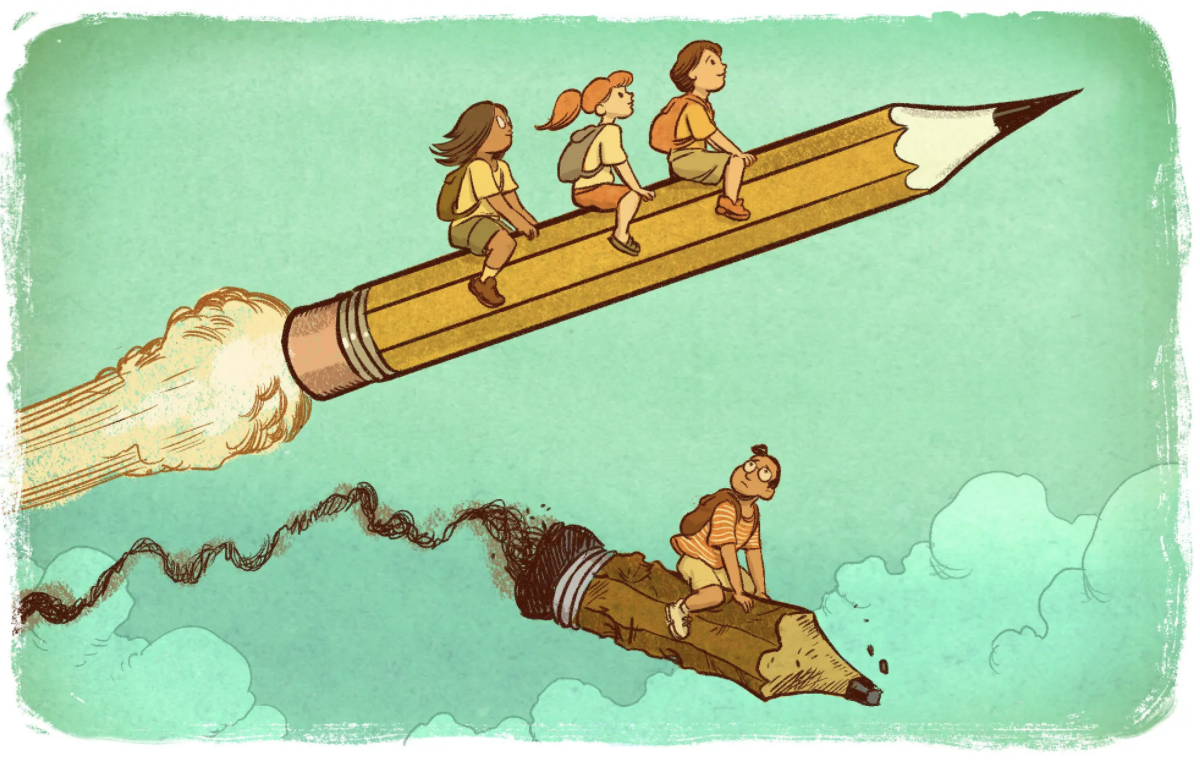
Educational Inequalities
by Jacob Yu
When I ran as an LAUSD student board member, I became more fully aware of the issues that deeply affect our district. When I attended the Student Superintendent Council Board meeting, many student representatives voiced their dissent and noted the racial and economic inequality within LAUSD. Listening to their complaints and concerns, I was inspired to research and continue exploring the issue of educational inequality in our school district. My continued interest and sparked passion from this event led me to produce this research article, which analyzes the history and roots of LAUSD educational inequality.
In the 1980s, Rodriguez vs. LAUSD was a court case started by Mexican American parents who noticed unequal educational treatment in their schools and towards their students. Mexican American community schools within LAUSD had subpar facilities, insufficient resources compared to White students, less money spent per student in comparison to wealthier White students, larger classroom sizes, and less qualified teachers. All of the aforementioned factors had a direct effect on the academic performance of students who attended these schools, with students attending primarily Hispanic schools scoring significantly lower in math and reading than students in primarily White schools. Although this case required LAUSD to uphold a consent decree where they would outline plans to alleviate the inequalities present within the district, the LAUSD legal department indicated they had no obligation to keep the school board updated on the Rodriguez case and subsequently released no reports regarding the progress on such an issue. The legal team in LAUSD only expanded after the consent decree, mainly to protect the district from liabilities rather than address the needs of the children attending these schools. To this day, LAUSD students within low-income neighborhoods do not have enough funds to maintain school facilities or hire better teachers. The money allocated and distributed by the government consistently goes to higher-performing schools rather than the neediest schools, failing to provide necessary quality education to low-performing schools. This scarcity in education disproportionately affects non-White students within LAUSD. In a paper published by the Speak Up Parents Organization within LAUSD, it was noted that one-third of African American students were less likely to achieve proficiency in ELA (English Language Arts) on the Smarter Balanced test, they were 3.4 times less likely to achieve proficiency in ELA and math in comparison to their peers, and the gap between African American and White students ranged from 28% to 40%. These figures clearly show a discrepancy between White students and African American & Hispanic students. In addition to being present in LAUSD, this issue is one that plagues American education across the nation.
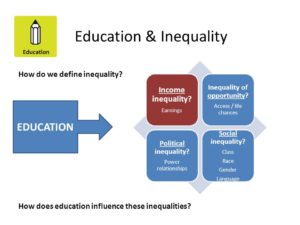
Inequality has been at the center of American economic and social issues. This can especially be seen in rising income inequality among races, an issue that affects individuals in very real ways. These effects are particularly present in the quality of high school and collegiate level education among the spectrum of income. There is significant inequality between racial groups, with White and Asians being classified as the highest income groups and African Americans, Native Americans, and Hispanics qualifying for the lowest income groups (Akee & Jones and Porter, 2019). Familial income has a significant role in school readiness and long-term success in school. Due to this, children attending schools with low-income classmates have worse academic performance and graduation rates compared to children attending schools with more affluent classmates (Duncan & Murnane, 2014). There are major discrepancies among racial groups in academic performance. A majority of racial minorities attend schools with low funding and have less access to educational resources in comparison to White students (Darling-Hammond, 1998). Further, the educational gap in relation to income has a direct effect on collegiate education, for there has been an association between collegiate inequality and income inequality, especially in recent decades (Micelle & Holzman, 2020).
LAUSD schools are funded by the state, mainly from income and sale taxes as well as local property taxes. Thus, a majority of the funding for LAUSD schools are based on the local environment that students live in. The national issue of educational inequality and discrepancies in academic performance amongst racial groups can be seen within LAUSD. For this article, I analyzed the most recent open source data demographics for each of the seven board districts within LAUSD and used statistical analysis to identify five major outcomes regarding race and income. Using data on the percentage of economically disadvantaged students and the rates of college completion within six years, I found a statistically significant negative correlation. This implies that as the percentage of economically disadvantaged students increases, the rates of college completion within six years decreases. Further, observing data on the percentage of non-White students and the rates of college completion within six years, I found a statistically negative correlation. This indicates that as the percentage of non-White students increase, the rates of college completion within six years decreases. In addition to this, using data on the percentage of non-White students and four year cohort dropout rates, I was able to find a statistically significant positive correlation. This suggests that as the percentage of non-White students increase, the four year cohort dropout rates subsequently increase. Moreover, when utilizing the percentage of non-White students and the percentages of students chronically absent, there was a statistically significant positive correlation. This notes that as the percentage of non-White students increase, the percentage of students grades 9-12 chronically absent increases as well. Finally, when testing both the percentages of students grades 9-12 chronically absent and the rates of college completion within six years, there was a statistically significant negative correlation. This means that as the percentage of students grades 9-12 chronically absent increases, the rate of college completion within six years decreases. These figures indicate that students who attend majority non-White schools are less likely to enroll or stay in college, drop out within four years of their high school experience, and be chronically absent from grades 9-12 than their majority White counterparts. Further, students who attend schools with high percentages of low-income families are less likely to enroll or stay in college than their higher-income counterparts, with chronic absenteeism from grades 9-12 being a factor in lower college enrollment and persistence. These outcomes clearly indicate that non-White students, particularly Hispanic and Black students, and lower-income students are at a disadvantage to their White, higher-income counterparts in regards to higher education. This was clearly evident in the difference in educational experience between students that attended schools on opposite ends of the racial and income spectrum.
One student, identified as Ash, attending a school in Board District 6 – a district with the second highest Hispanic population, highest percentage of economically disadvantaged students, lowest college enrollment and completion rates – noted how his school’s resources and funds were used in unproductive ways, explaining, “I feel like our funds could have gone towards many other things such as sports, more teachers, more academies.” When asked about his peer’s living situations in regards to their educational experience, he also noted how, “Some people have terrible living conditions or sometimes they have siblings they have to deal with. For example, I have a little brother and sometimes I gotta help him. And with athletics and everything, I gotta be home at, like, 6:00 or 7:00. And trying to get my homework done and my siblings – it’s kinda difficult sometimes.” He also commented on the lack of counselors, college visits, and tutoring within his school. This has had an impact on his higher education aspirations. When asked about if his school was preparing him well for college he said, “No, not really, just a lot of general stuff, nothing specific that helps you towards your degree. I mean, as I said earlier it’s a lot of information to be processing in a day.” Ash also observed how many of his peers applied and attended community college due to the high cost of universities or four-year colleges, saying, “Yeah, it actually does, like whether like if it was someone that was making more money they probably were able to go to a prestigious college rather than someone that’s a low income family, they probably go to a community college… It sometimes worries me thinking how much the cost of education will be, if I can afford it.”
The difference between Ash’s experience and that of another student who lives in Board District 6, a district with the highest college enrollment and completion and White enrollment, and the lowest percentage of economically disadvantaged students, is clear. The student, Tara McKillop, noted how a majority of her teachers were well-qualified, stating, “Of the teachers that are my favorite, they have engaged the students in learning and stuff like that, but they’ve also shown that they prioritize the student’s education and also emotional status too. I would also say that with those teachers that they are overqualified in the sense that they could be doing so much more than just teaching and we, the students, show that we are really grateful for that. We do have a good amount of APs offered at our schools and the teachers for those are really nice.” She also noted how a lot of the AP classes were filled with White and Asian students, rather than Black or Hispanic. When asked about the support that she receives for her high school education, McKillop stated, “Something that my school offers is lunch tutoring, by students for students. Some of my teachers also do provide tutoring and stuff like that so I think overall my school understands the kids’ situations.” She also stated how, “My parents do support me in my educational experience and I would say also my teachers have been a big influence on it. They’re there for the students to help them out with anything that they need.” When questioned about college preparation, McKillop noted how her college center has easily accessible resources and helpful college counselors. She also commented on the college educational aspirations and experiences of her peers, stating, “So the graduating class that I was close to, a lot of them got into Santa Barbara and San Diego. So, a lot of them are getting into UCs top colleges. I know quite a few of them were able to also go out of state.” This difference between Tara’s and Ash’s schooling and experiences towards higher education directly reflects the disparity that students within LAUSD experience.
This inequality in education continues to go unheard as thousands of students from similar backgrounds as Ash face similar obstacles and difficulties that other students simply do not experience. We must do a better job of being there for our kids.
Read More
Egyptian Short Stories
At the conclusion of our unit on Ancient Egypt unit, the 6th grade students submitted short stories that reflected what they learned about Egyptian society, government, and religious beliefs. Here is a sampling, along with students’ original artwork.
The Creation of Life
by Charis K.
For many people, the coming of summer is a blessing as it brings warm weather for crops to grow. It was also a large blessing for the ancient Egyptians; they believed that Renenutet, the goddess of nourishment and harvest, would provide them a bountiful harvest. However, one summer was far from a blessing as floods came and destroyed fruits such as figs and dates. The floods destroyed all the fields except those growing wheat. With an abundant amount of wheat but lacking fruits and vegetables , the king announced that if a cook could be used the available crops to create a successful dish, the recipe’s owner would be given the privilege to live in the palace with the royal family.
Up on the highest hill in the kingdom far from the floods lived a farmer named Aharon and his daughter Akila. When Aharon harvested the wheat and fruits, Akila would weave the wheat into beautiful baskets and fruits into delicious jam. They were a poor but happy family. However, they barely paid for their land with the money they made at the market, selling figs and dates. When they heard of the king’s announcement, Aharon rushed to Akila and asked if she would want to take on the challenge. Akila, who enjoyed cooking, agreed and started to gather materials. Next door to their home lived a sly woman named Anippe. She looked friendly and caring, but she hated Aharon’s family because she felt competition. Knowing Akila’s amazing cooking skills, she decided to wait until Akila created a recipe so she could steal it and win the prize. So she waited for 6 months until she heard Anippe squeal with delight as the air filled with a delicious aroma. She quickly knocked on the door and caught a glimpse of Akila’s papyrus roll full of different recipes. As she casually talked with Akila, she slipped the most recent recipe into her basket and quickly excused herself. Before Akila could realize, Anippe ran to the palace to claim her creation.
When she reached the palace everyone was stunned by the amazing smell and the taste. Just before the king could grant her the prize, Akila rushed and said, “That is my recipe and the woman, Annipe, has stolen it.” Everyone was stunned but did not believe her. However the princess, Sara, saw through Annipe and knew that she had not made the dish. Therefore, she suggested holding a small competition to find the real owner of the recipe. Each woman would be granted two stalks of wheat, a bundle of grapes, and five large, ripe dates. The one who makes the dish perfectly without the recipe would be the winner. Annipe, panicking, added all of the ingredients in a bowl and over baked them. However, Akila ground the wheat, extracted the juice from the grapes, created a thin syrup with dates, and baked it for just the right amount of time. While Akila’s dish was soft, sweet and delicious, Annipe’s was hard and burnt. Seeing this, the king threw Annipe into prison for her deceit, and Akila and Aharon lived in the palace happily. Akila named the creation “eish,” which meant living, as it had stopped the famine and led to many healthy and happy people.

by Jonathan R.
The Fate of Khufu
by Brian S.
It’s 2520 B.C, and after much work by his subjects, King Khufu had finished the Pyramids of Giza a decade ago. Settling in with satisfaction, Khufu collected the tribute from his conquered lands.
“Thank you, and thank you, and thank you,” said King Khufu, while collecting the tribute of gold and other riches. All the people from the lands he conquered had to pay this tribute, or face dire consequences.
Later, while his viziers were doing much of his work for him, Khufu was enjoying his beautiful garden, where he could wander around until his dinner. Khufu took a deep breath in and announced, “Free time is sometimes all a pharaoh needs to stay calm and ready for life. What a beautiful gar–” In that brief instant, an assassin had stuck a knife to his back, causing Khufu to fall to his knees and cough out blood. Before the guards could arrive, Khufu had died. His final sights were the flowers and bushes in his garden, and the pool of blood around him. He realized his time had come, and closed his eyes to prepare for eternal darkness of death.

by Reece L.
He woke up after what seemed like several hours, to a room surrounded by 42 gods, with some who Khufu knew, such as Anubis, the jackal-headed god of the dead, and Ra, the Sun God. Then, one of the gods stood up and announced, “Welcome, King Khufu, son of Sneferu. You were assassinated with the use of a knife, and are now here at the sacred Weighing of the Heart ceremony. To pass the ceremony and join your ancestors, your heart must not weigh more than the feather of Ma’at, the goddess of truth and purity. Otherwise, your heart will be fed to Ammit, and your soul will be stuck wandering Egypt for all of eternity. We will begin with your Negative Confession. Now, in front of all the gods and former pharaohs, list the sins you have not committed.”
Khufu could immediately tell that the god was Osiris, since he seated at a magnificent throne. Behind him stood his wife Isis and her sister Nepenthes, watching the ceremony. Khufu stood up and walked to all the gods, stating the sins he did not commit, all while Thoth, the god of wisdom and sacred scribe, used his pen to write down all the sins not committed. After about an half-hour Khufu’s various not-committed sins, Osiris announces, “Now that the negative confessions were written down, your heart, Khufu, will be placed on a scale and weighed against the feather of Ma’at, and we will determine if you get to pass, or if your heart will be eaten by Ammit.”
Khufu’s heart was placed on one side of a golden scale, while on the opposite side, Anubis, the god of the dead, placed the feather of Ma’at. Khufu watched as his own heart beat faster as he awaited his final destination, and the other gods started wondering what his heart was doing, as they had never studied the anatomy of a human body.
Finally, the weighing was over, and Osiris announced, “King Khufu, your heart weighs the same as the feather of Ma’at, meaning you are allowed to reunite with your ancestors and farm in the fields for the rest of time. Enter through the doors in front of you to enter your new home. Congratulations to King Khufu, son of Sneferu.”
Relieved that he can now visit his dead parents and grandparents, Khufu thanked the gods and entered through the doorway, revealing a large field of wheat, a beautiful garden, a comfortable home, and his long lost ancestors. He was happy to live here for the rest of time, even if it meant he no longer has access to his riches back on earth.
Anipe’s Revenge
by Sofia K.
Light flooded her eyes as Anipe opened them to a room full of indescribable scents and colors. She felt tired, as if she had just woken up from a long rest. Unbeknownst to her was how she had gotten there, and she searched her memory in a panicked frenzy. Finally recognizing the scenery from paintings of the Hall of Osiris, she still couldn’t figure out how exactly she had come to be there.
It had been her coronation: they had spent weeks preparing for the celebration, and Anipe had been waiting for the day the throne would be handed to her. She had made sure everything was perfect; an offering was given to every god, a plate for every guest, and food was prepared to the best of the cook’s abilities. Had one of her servants deceived her? Perhaps one of the cooks poisoned her food? Or maybe someone slipped something in her drink? No, that couldn’t have been it, she thought to herself.
After all, it had been her younger brother who had picked out the wine especially for this day which she had been looking forward to for so long. Abrax would never have let someone poison the wine while it was left unattended. Suddenly, Anipe’s blood ran cold. He hadn’t left the wine unattended, he had been the one to poison it. As soon as the realization struck her, she felt utterly stupid. Abrax, the person she trusted more than anyone she knew, had been the one to betray her? It couldn’t be. But the more she thought about it, the more it made sense to her. He was the next in line to the throne; if she was gone, there would be no one in his way to power.
Anipe’s thoughts were interrupted by a deep voice urging her to come forth. Looking around she realized she was surrounded by gods, waiting for her to recite the Book of the Dead. She recognized the person urging her to come forth as Osiris, and as she neared where he stood, she caught a glimpse of the feather of truth. The feather was unlike anything she had seen before: it was as if it was made of light itself. Anipe brushed off her previous thoughts of the betrayal, she needed to focus now if she wanted to avoid a terrible fate. She began to recite her Negative Confession as the gods around her watched. She wasn’t worried about the fact that what she said could be counted as false. Considering what she was being judged on, she had done no wrong. After she was finished, she watched in silence as her heart was weighed on Anubis’ scale, to ensure that it was not heavy with sin. Not to worry, it was perfectly balanced with Ma’at’s feather of truth. As pleased as she was of the outcome, Anipe could not shake off the feeling of hatred and resentment she now held for Abrax, who had caused her death.
Although the afterlife had been everything she had been told of and more, her thirst for revenge only grew stronger by day. No longer being able to bear the hatred that was eating Anipe up from the inside, and she went to consult one of the other past pharaohs for his advice. Each and every one she consulted told her the same thing, “The feeling will disappear with time and be replaced by a feeling of content” or “You must let go of those feelings” and a lot of other nonsense; none of them seemed willing to provide her with the answer she had hoped for. She tried her best to forgive or even forget what had happened, but time went on and days passed slowly.
Anipe was able to live with the feelings she had. After all, what else could she do? She pushed her vengeful thoughts into the back of her mind and was able to live a content, peaceful afterlife. That was, of course, until she saw him. Seeing Abrax changed something in Anipe. As she walked up to him and saw him dressed in amulets and ceremonial pieces adorned with gold, lapis lazuli, and amulets that were meant for the pharaoh, she was engulfed in rage. Yet she remained calm, faked a smile, and made an attempt to strike up a conversation:
“It’s been too long, Abrax! Welcome to the afterlife, it’s magnificent! Don’t you agree?”

“A Memory in Time” by Sahithi P.
After a long blank stare Abrax answered, “I’m sure it is, as an accomplished pharaoh must lead a glorious eternity. Now fetch me something to eat, will you? My ceremony has been postponed until tomorrow due to some conflict between my fellow gods and I’d rather spend my time here in comfort.”
Anipe’s blood boiled. After all he had done to her, he regarded her as if she was a servant. She didn’t know what she had expected, for him to beg for forgiveness? Or maybe just an apology. At the very least recognition.
Finally she asked, “Aren’t you worried? After all, you won’t be spending long here. The horrors of the other afterlife await you.”
With a laugh Abrax responded, “You think I’m that stupid? I ordered a servant to poison the wine. As I did not do it myself, that horrible eternity will not be mine to endure,” he said smugly.
As this realization came upon Anipe, she felt defeated but suddenly had an idea, “Thank goodness,” she replied with a fake sugary voice. “You deserve to be here just as much as I do, I’ve come to realize this after all my time here.”
“I’m glad you have come to your senses,” Abrax said with a cold smile.
As soon as Anipe was able to flee from the dreadful small talk she had been forced to engage in, she quickly made her way to where Ma’at kept the feather of truth. Anipe quickly switched the feather out with a regular ostrich feather with a smirk on her face. Now all she had to do was wait. Anipe wished Abrax good luck for his ceremony with a wave and a cheery, “I hope to see you back soon!” Without looking back Abrax replied, “Yes, I hope the ceremony doesn’t drag on for too long.”
Those were the last words Anipe heard from Abrax, for he never did return….
Read More

Uncovering Egypt
by Ava-Ray Pributsky
You may think that most of Ancient Egypt has already been discovered and that there is not much new to find. However, that is not the case. Even as recently as the last couple of years, there have been multiple discoveries of vast new burial sites in the region of Saqqara, located in Giza Governorate, Egypt. In November of 2020, archeologists found over 100 wooden sarcophagi, some of them with mummies inside, and over 40 funerary statues. These artifacts were from 2,500 years ago and “in perfect condition of preservation” according to Khaled el-Enany, the Egyptian Minister of tourism and antiquities. Even more recently, in January of 2021, archeologists found 50 more tombs in Saqqara. To share this discovery with the public, Harvard University has created a special virtual tour of one of the excavated tombs.

Archeologists Examining Artifacts at Saqqara
(Link to Tour)
This year, the 6th grade Ancient Civilizations history class at Science Academy has been learning about Ancient Egypt. We first studied the geography of Egypt, how the Nile helped the Egyptian people, culture, and their civilization flourish and survive, as well as how the Nile Valley protected Egyptian civilization from outside forces. Then, we started to learn about the Old Kingdom and the Middle Kingdom, briefly touching upon the Early Dynastic Period. We also learned about the pharaohs who ruled during those periods. Most pharaohs had elaborate, mysterious, and mesmerizing stories behind them, parts of which are still missing and lost in history. We also looked at the Step Pyramid of Djoser, the Great Pyramids of Giza, Hatshepsut’s Temple, and many other important monuments and tombs that were built during the time of Khufu and various other pharaohs. In addition, we delved deeply into the Egyptian pantheon of gods and their rich culture, as well as some of the Egyptians’ advances in mathematics, astronomy, and medicine. Finally, we covered the New Kingdom and its rulers, as well as the sad end to the civilization that was the prime trading center for centuries and the home to one of most beautiful civilizations for over 3,000 years.
As a final project, our class was asked to give an opportunity to work on an Extra Credit project where we wrote an original piece about Egyptian culture as well as an original art piece inspired by Egyptian culture. Here is a gallery of some of the students’ wonderful work.
Hymn to the Nile
by Muaz Reza
All hail to the Nile, the greatest river there is.
Who submerges thyself among the barren lands of Egypt.
Bringing growth to places visibly uninhabitable
Allowing life to sprout and thrive with great joy.
As your water calmly floods our dry lands
It brings pleasure to even the heaviest of frowns
Not a single heart grim, not a single heart sullen.
But brimming with life, awakened for the new season.
Your waters are what allowed us to grow
First a colony, then a kingdom, then finally an empire
We will cherish the gifts that you have provided us
For without them, we would surely cease to exist.
And as we harvest the bountiful crops
Which grow in the fertile lands you have provided
We await once again, your magnificent arrival.
To begin the cycle of life all over again.

Miracles of Ancient Egypt: The Snake-Man and his Master
by Tarisha Hasan
As a farmer, Ahmed worked his fields and tended to the city projects and tombs when the fields were flooded. One day, however, the pharaoh’s only son had died of a mysterious disease. All the citizens panicked, for they knew the pharaoh was aged and nearing the end of his life. As he helped in building the tomb for the prince, he wondered if there was still hope. After the tomb was complete, Ahmed went home to consider the current situation. The late pharaoh’s officials were still trying to find someone.
Ahmed decided that it was finally time to do something. He took to training carefully as a scribe. He hired an artisan to carve a cartouche for the new pharaoh, who was female. The artisan obliged. When the carving was finished, a courier was instructed to deliver the stone carving. However, there was a problem: the weather was bleak and overcast. After a while, it was agreed that the carving should be delivered in a protective covering. When it was finally delivered, however, a lightning bolt struck the herald while he was making his way back.
Back at his mansion, Ahmed was calmly reading a papyrus scroll in his library with his hired artisan when another courier of his came running to his door.
“Master!” Hossain called. Ahmed suddenly turned his head in the direction of the cry. He ran to his other courier as he was certain his prior request would go smoothly.

“What is the matter?” Ahmed was worried. Never before had a close one of his get injured on his watch. The courier said that someone was injured, and they both set
out to save their ally.
By the time they found the first courier, he was in a doctor’s office, lying wounded and exhausted. Hossain asked the doctor how his colleague had become the way he did. The answer was shocking.
“The lightning strike was an omen.”
“What exactly do you mean by this?”
“It’s hard to say. Nevertheless, see that he stays safe. Come back again if he displays any more symptoms.”
Ahmed slowly nodded. He and Hossain carefully carried their ally back home, taking care that they carried him high enough. When they finally got back home, the injured messenger was put to rest.
The next morning, the ill courier began to show signs of severe illness. When he was awakened, it was revealed that the courier’s right hand was growing scales. The same had ha
ppened to his left hand, raising worries. Even after the scales were removed, they kept growing back.
“You’ll have to go to a priest,” the physician said. Even after he tried the spells that they prescribed, they only partially worked. Some of the scales did disappear, but they soon began growing back.
“What shall we do with you, Asaad?” Ahmed asked. “All the cures we tried either don’t work or only work temporarily.” Asaad simply replied, “The reason why there is no permanent cure is that this was destined to happen.” This struck the other two silent for a couple moments. Ahmed then said, “So you knew this was all going to happen?” Assad related his whole story of the particular circumstances he grew up in and how it contributed to his developing lizard-like appearance.
“The only thing you can do right now is let the transformation happen and leave me in peace.” Ahmed realized that there really was no point in trying to find a cure. As a result, he instructed his other herald to make accommodations for Asaad while he went into his chamber to write an entry on his small papyrus journal. A few days later, Asaad was still the same person he was before he became lizard-like. However, word had spread in his town, and people came to inquire after the strange lizard-man he kept as a servant. Ahmed tried his best to keep all the visitors at a distance, but it was no use. Smaller reptilians were not usually common where he lived, let alone hybrids of humans and lizards.
When Ahmed tried to rest after a long day, he found that he was unable to, as he had spent all day fielding requests from his clients to write letters for them. He decided to take a drink that Hossain had offered him, and then after that, he slept rather uneasily through the night. When he woke up, he was more determined than ever to find out the cause of this mutation. He researched for days without stopping, and that’s when he finally found out the cause.
It was revealed that Assad had come from a family of snake charmers outside of Egypt’s borders and that he had caught a rare and incurable disease after a snake bit him. He did survive, but at a great price: he was to become a snake-man. A valuable lesson was learned from this event: no matter how hard one tried, there are times where fate was inevitable and had to take its course.
A Memorable Day in the Life of an Egyptian Farmer
by Mayukh Day
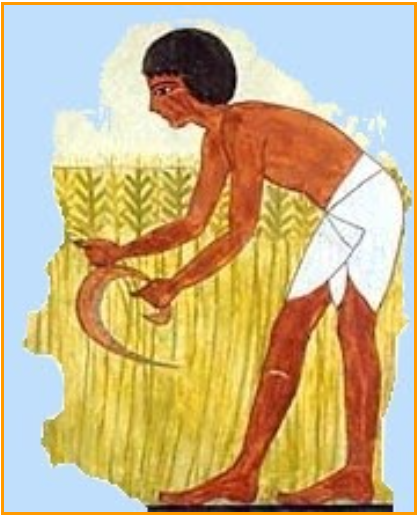
It’s August and the day of the annual flooding of the Nile. This annual flood has been an important natural cycle in Egypt since ancient times. Today is the day where it’s decided how much water Mafas II gets throughout the year.In the morning the farmer, Mafas II, gave a prayer to Osiris, the god of agriculture for lots of water today. Since his wife is pregnant and can give birth at any time, Mafas II, gave a prayer to Bes, the guardian god of childbirth. Next, he ate
his breakfast and set off into the fields, imagining what he would do in the fields today.
In the fields, he first uses the shaduf to irrigate his fields carefully. Then, he puts the stone markings for his boundary of water. After all that hard work, Mafas gathers a few cattle and a few ducks for his meals. Then he returns back to his house for supper.
Then he gives evening prayer to Bes, the guardian god of childbirth, and Osiris, the god of agriculture. For supper he eats meat, bread, and beer. After supper he plays twenty squares and Senet with his son. He stays up late when everyone in the family sleeps.
Then at the dark of night, the farmer paddles nervously out and shifts the stones to steal a few feet of water from his neighbors. Mafas knows this is very profitable, but the penalty of this crime could mean death. Thankfully, no one noticed him do this crime. Mafas goes to bed dreaming of his day tomorrow.
Naunet’s Journey
by Ava-Ray Pributsky
I walk down the dusty dirt path as I head to do some research at The House of Life, to look up medical papyri for how to treat a headache. My patient Abasi, one of many grandchildren of Rameses II, has been complaining of a sharp pain in the back of his head every morning for the past week. Having been trained by my father Djehutyemheb, a wise scribe and physician to the royal family, I am now able to care for royalty. I have given him amulets from the Goddess Isis and the God Heke. Isis is invoked because Abasi is sick and Heka to make the prayer more powerful. I will continue to look for additional cures. It is 1259 B.C.E, and Pharaoh Ramses is in rule. Kemet has just signed a peace treaty with the Hittites, who we have been battling with for several years. I have not known a time when we were not in war with them. Ramses II has spent too much money on fighting, so he decided to make peace with them.

This is the first peace treaty ever for Kemet. I am intercepted on my path by Maat, a young girl servant to Ramses II who has only just started working at the palace Ramesseum. “Naunet, Sese’s daughter Meritamun has a growth in her left eye! She is deeply upset and refuses to go outside for fear of people seeing her.” I try to calm her down and explain to her how I will create a mixture of red ochre that I can get from Abubakar at the temple, green eye-paint of malachite that I can pick up at the House of Life, and honey from the beehive near my house, and I will come to the palace and apply this to the growth two times per day. I also will take some black tea leaves, wrap them in muslin, soak them in hot water, and apply it to the eye. Finally, I will give Meritamun an amulet with the eye of Horus for her to wear. I continue my way down to The House of Life, thinking about the incantations to be prepared.
When the Sun Did Not Rise
by Genessis Gomez
Deep in the underworld there was a serpent called Apophis who detested the sun god Ra. Every night as Ra descended to the underworld for his nightly trip, Apophis was ready with another scheme. That fateful morning was coming, as people started to wake up confused that the sun had not risen. Farmers and merchants walked with lanterns to the places they usually worked confused, thinking that they woke up earlier and that the sun was going to rise very soon. But the priests, who knew about the serpent Apophis, hurried to the temples to help Ra.
The hours started to go by and the farmers, merchants, and even slaves started to worry. As the priests started to gather what they needed and muttered spells from the Book of Dead, the people outside started to pray very loud hoping that Ra was not dead. Back in the underworld, Ra received the prayers and spells (spells were also put on Apophis which was making him weaker). Ra received more power from the human praises above and soon enough he was able to fight off Apophis. He continued to float through the underworld and the sun started to rise again. From that day on, the Egyptians prayed that Ra had a safe passage and never forgot to thank him for the light he gave them every day.
Oh, What Greatness Comes When the Nile Flows
by Ezra Ipsa
Greatness that comes when the Nile flows,
It gives life to Egypt watering fields warmed by Ra,
Allowing our crops to grow so our cattle can live,
And we have food to eat.

Home of the fish, you give us grain and create barley,
Letting us ensure perpetuity to the temples,
And for the gods.
When offerings are made it is thanks to you,
Spreading all through Egypt, the creator of greatness,
You give us water to drink and to give to our livestock.
O, what greatness comes when the Nile flows,
It lets us thrive and prosper,
Like one with the gods we praise you,
For all you have done for us.
A Day In the Life of an Ancient Egyptian Scribe
by Jordin Lin
The sun leaked through the window of the Abasi’s adobe house. He frowned; morning had arrived. Hardly awake, he stood up from his bed and went to take a quick bath. Once finished, he got dressed into more appropriate clothing: a waist-to-knee kilt with a sheer blouse. Abasi was a stern man, as his name did mean ‘stern.’ He was very serious about his role as a scribe. The man absolutely despised it when something got in the way of him doing his job, so he made sure to meticulously plan out his day every morning so that everything would go smoothly. After changing into his outfit, he walked over to his nearby table to eat breakfast. The breakfast he usually ate was simple: lentils, bread, and eggs; it was enough to keep him going until the next meal.
Once he finished with his breakfast, he took out a small piece of papyrus, a thin, reed brush, and some ink. He slowly wrote down a detailed plan of how his day was going, starting from when he finished his breakfast. The main, and only, event on his schedule was to go down to the village and write down what was happening, specifically about the workers as did their labor. After 10 minutes of a walk in the hot sun, Abasi arrived at the nearby village. He looked around and took out his plan for the day. First, he would watch the over farmers, then the carpenter, then the washerman, then lastly, the maker of pots. Placing the note back into his small bag, he readjusted his posture, making sure he looked as presentable as possible

With one last stroke, he was finished for the day. Abasi nodded to the maker of pots, indicating that it was time for him to leave. The pot-maker nodded back at Abasi as he started to place up his papyrus, ink, and reed brush back into his small bag. Once Abasi completed packing up his materials, he exited the workshop. Surprised, he noticed that the sky was already quite dark. He had not noticed how much time had flown by. Quickening his pace, he speed-walked back to his house, ready to eat dinner and go to sleep. Abasi loved the sense of fulfillment every time he did his job without realizing the passing time. Today was such an example. Hours of work felt like only a few minutes. He lied down into his bed, smiling to himself. Rolling onto his side, he fell asleep, preparing for the next day.
The Horizon of Heaven
by Milan Riley










Resources:
Egypt Unearths New Mummies Dating Back 2,500 Years – New York Times
50 ancient coffins uncovered at Egypt’s Saqqara necropolis – The Guardian
Five-thousand-year-old Egyptian tomb opens for virtual tour – The Guardian
Tomb of Queen Meresankh III – Harvard University
Read More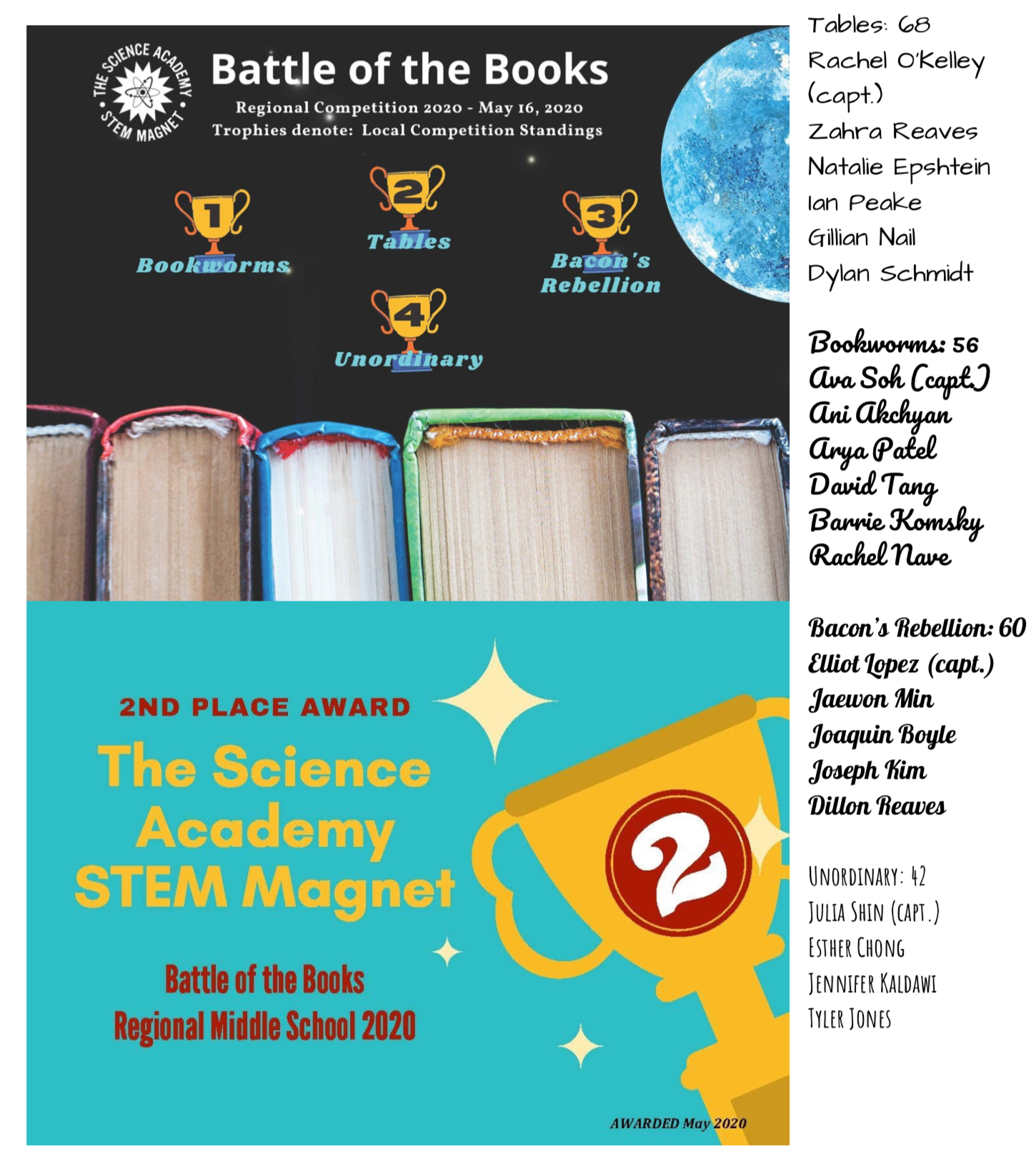
Science Academy Takes 2nd Place at Battle of the Books
Science Academy Team Takes 2nd Place at First-Ever Virtual Battle of the Books
by David Tang
On Saturday, May 16, 2020, the Science Academy STEM Magnet took part in their first Battle of the Books competition in our school’s history! The ranks in the image above represent their placing in the local competition, which took place at the Science Academy, competing with the other Academy teams. The scores represent points scored by each team at the regional competition which took place over Zoom. The scores of each team from each school were added and compared to the other schools. The Science Academy was second to Walter Reed; you may, however, be happy to know that we crushed Millikan Middle School.
For Battle of the Books, each team had to read all 20 books on the book list collectively. Typically, teams split up the titles between the members, but most of the Science Academy competitors read all 20 books. The book list included the first Harry Potter, Stargirl, Shadow and Bone, Amal Unbound, Esperanza Rising, Hoot, The Phantom Tollbooth, and Playing Atari with Sadaam Hussein. Together, teams have to answer questions about characters, events and details from any of the 20 books. Each question is phrased in the form of “In which book did…?” The team earns one point for naming the correct title. If they correctly name the title, they would then earn another point for the correct author. There were 40 questions (80 possible points), and each team competed separately. It took approximately 4 hours. Thank you so much to Ms. Garcia and Ms. Butler for working so hard and helping our teams prepare. It was a lot of work, but it really was also a lot of fun! Congratulations to all the team members!
Read More
The Oscars 2020 | 92nd Academy Awards
The 92th Academy Awards were held at the Dolby Theatre on February 9th, 2020. The Academy Awards, or more popularly known as the Oscars, are awards for artistic and technical merit in the film industry. The awards are given annually by the Academy of Motion Picture Arts and Sciences (AMPAS). The awards are an international recognition of excellence in cinematic achievements as assessed by the Academy’s voting membership.
This year, during the Oscars, records were broken. Parasite, a Korean film, won four awards, including Best Picture. This is the first time that a non-English language film has won the Academy Award for Best Picture. Parasite also won Best Directing, Best International Film and Best Original Screenplay, among others. Before Parasite was released, most non-English films were only considered in the foreign language category. Parasite not only won four Oscars, but made waves in America with its sensational story line and examination of socio-economic conflicts. In addition, it performed very well at the box office for a movie with sub-titles!
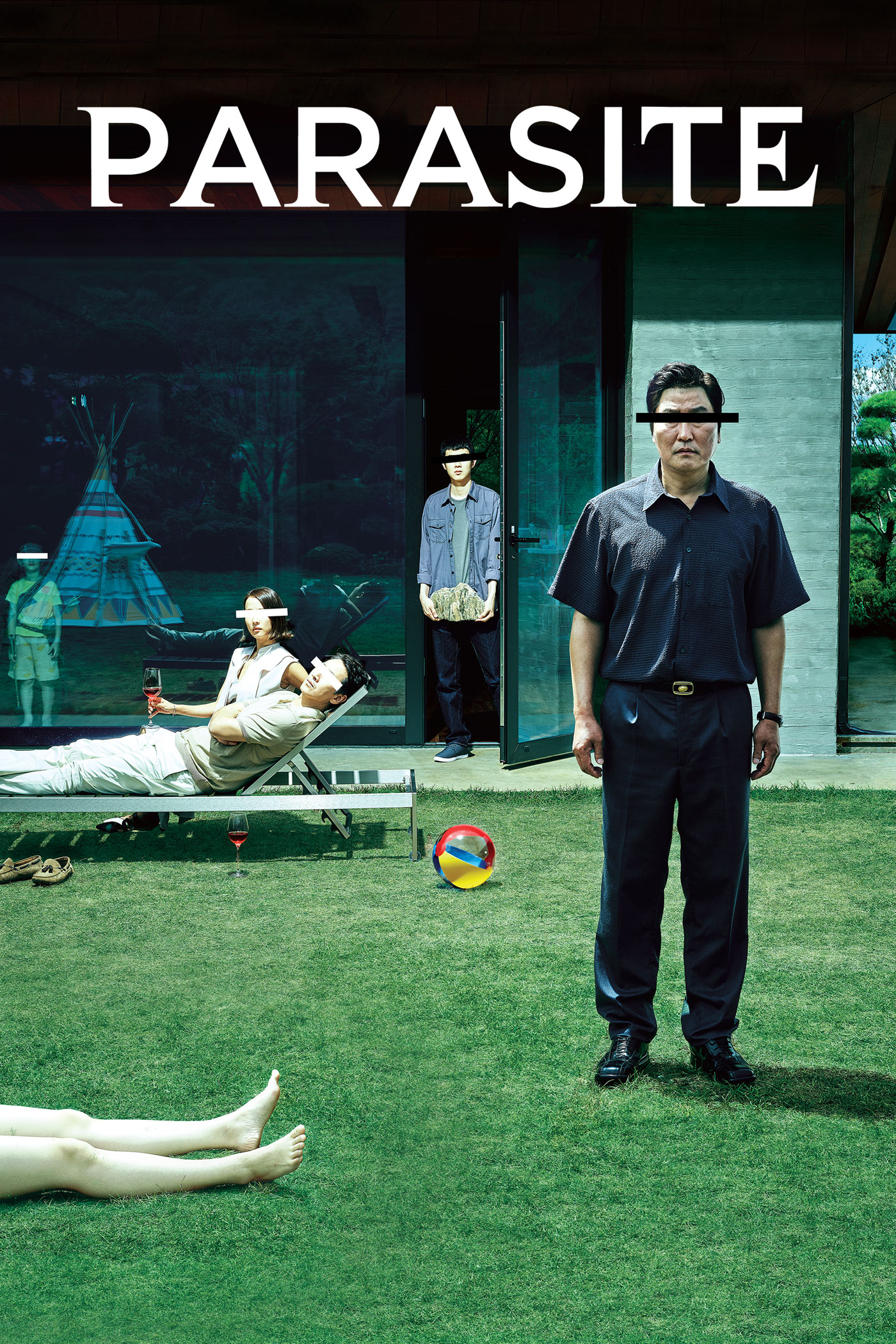
Joker is the story of a mentally ill, failed comedian, Arthur Fleck slowly transitioning into the criminal mastermind known as Joker. The film’s leading actor, Joaquin Phoenix, won the Oscar for Best Actor. He used his win to give a voice to the voiceless. He continues his trend of drawing attention to sociopolitical issues. In previous award ceremonies, global warming, veganism, gun violence, and diversity in films. During the actor’s acceptance speech at the Oscars, he touched on social inequality, the cruel treatment of animals in the food industry, systemic inequality, and even cancel culture. To end his speech, he quotes his late brother, River Phoenix: “Run to the rescue with love and peace will follow.”

The award for Best Actress went to Renée Zellweger for her portrayal of Judy Garland in Judy. Judy is about singer and actor Judy Garland arriving in London to perform sold-out shows at the Talk of the Town nightclub. While there, she reminisces with friends and fans and begins a whirlwind romance with musician Mickey Deans, her soon-to-be fifth husband. Zellweger started her acceptance speech by acknowledging the other nominees. She continued to thank all those who have helped her in her career. After talking about the people who have supported her, she goes on to talk about Judy Garland, the person Judy is based on. She talks about how the people who inspire us to find the best in ourselves, our heroes, can unite us. When we celebrate our heroes, we’re reminded of who we are as one people united. She talked about how this Oscar win is an extension of Judy Garland’s legacy. It is a celebration of her unique exhibitionism and generosity of spirit.

Brad Pitt wins his first Oscar for acting. He won Best Supporting Actor in Quentin Tarantino’s Once Upon a Time…in Hollywood, a story about actor Rick Dalton gained fame and fortune by starring in a 1950s television Western, but is now struggling to find meaningful work in a Hollywood that he doesn’t recognize anymore. He spends most of his time drinking and palling around with Cliff Booth, his easygoing best friend and longtime stunt double. Rick also happens to live next door to Roman Polanski and Sharon Tate. To start off his acceptance speech, Pitt started with a political remark, saying that he only had 45 seconds to deliver his speech, which is “45 seconds more than the Senate gave John Bolton this week.” During his acceptance speech, he paid tribute to the stunt community, but most importantly, his kids. He talks about the lack of stunt awards in the Oscars. He also talks about how his kids have been everything to him.


The Newcomer’s Guide to PCs
PLUS Recommendation for Mid-Range Build
Jose Salamanca and Gideon Said
Building a computer provides many different advantages. First off, building a computer is cheaper. You can custom pick your parts allowing you to suit your needs, whatever they are. If you are planning on playing games, you can make sure you build a computer that will be able to play all the games you want without paying for extra, unneeded features. If your primary usage of a computer will be receiving and sending emails or occasional media usage, you can make sure that you get what you need. Building a computer also lets you have a PC designed to specifically fit your environment. If you want a small PC to fit in a tight space with wireless WiFi, typically a prebuilt PC is not going to cut it. Building a PC also allows you to easily upgrade your PC if it becomes too slow for the tasks you want to do. And to top all of these things off you also no longer need to deal with preinstalled bloatware.
Motherboard-
The motherboard links together all of the key components of a computer and allows them to communicate and work as one machine. A good motherboard that will last many years of use and have plenty of upgrading capability in the future, is ideal. The motherboard also connects to external peripherals such as the monitor, keyboard, and mouse. It contains many different ports that connect to its cases input/output (I/O) shield. It provides connections for all kinds of external accessories and lets those accessories send inputs into the computer as well. The motherboard contains the peripheral component interconnect (PCI) slot and random access memory (RAM) slot as well. It retrieves power from the power supply unit (PSU) to allow the many components connected to it run. Some parts of a PC, however, do not get power distributed in the motherboard provided to them and instead have separate linkages to the PSU.
Central Processing Unit-
The central processing unit (CPU) is the brain of a computer. It sends instructions to the different parts of the computer and performs all programs required by the PC’s user. It computes all the tasks set to the motherboard. It performs all types of data processing that is required. It solves complex programs and displays the results on your monitor. The CPU influences all computer performance, which affects the speed and fluidity of the computer’s software.
Random Access Memory-
Random Access Memory (RAM) temporarily stores data and serves as the working memory of the computer. It allows PCs to work on multiple tasks at the same time by storing data from all programs currently being run. RAM can be viewed as the tables or work space of a PC. RAM can be used as many small ‘tables’ or one big ‘table’.
Graphics Card-
Graphics cards (also referred to as video cards) render images that are to be displayed on the monitor. A better graphics card will produce smoother images and videos on your display. A faster and more powerful motherboard allows higher graphics quality and resolution while at high frame rates and refresh rates. Graphics cards allow you to play games smoothly while at high resolution. A high-end graphics card is also key to advanced video editing allowing you to view every frame of a video at high resolution.
Storage-
Storage is used for data storage as the name suggests. The storage components of a computer are used for long term data storage as opposed to RAM. It stores usually stores data in the form of documents, Windows itself, and photos or videos. There are two types of storage. Hard disk drives (HDD) and solid-state drives (SSD). SSDs are faster but are more expensive. They store data in flash memory, which is far faster than hard drives that store data physically, via a spinning magnetic disc. Hard drives, however, are better for large, bulk storage for a better price. A happy medium of both works best, however, giving you lots of storage for things like documents and photos in a hard drive. The SSD would store Windows, games, and other things you want to be able to run quickly.
Power Supply Unit-
The power supply unit (PSU) provides power to the entire computer. It powers the motherboard and any other components that do not energy distributed from the motherboard. A good power supply also dictates component upgrading in the future because your parts could have a wattage too high for your PSU to support if you upgrade them. Higher-end parts typically use more electricity as well as larger or more powerful cooling systems.
Cases-
The case is the final part of a PC. It is designed to be aesthetically pleasing to yourself and others. It also contains all of the PC’s components like the motherboard and PSU and also any cooling. Many cases have red, green, and blue (RGB) lights integrated into them or, added by the PC’s builder separately in the case. The case is typically used to show off your PC components and RGB or to contemplate its environment.
Mid-Range Build-
This is a mid-range build, designed to handle many of the latest AAA games. Here is a link to the build on PCPartPicker: https://pcpartpicker.com/user/Journalism/saved/BBsYgs
CPU: AMD Ryzen 7 2700X
The AMD Ryzen 7 2700X has clocks at 3.7 GHz with overclocking capabilities up to 4.2 GHz. It is an octa-core processor with 16 threads. This provides powerful performance for its price which is the main reason it was chosen for this build. It also comes with a fully RGB Wraith Prism cooler.
Motherboard: Asus Prime X470-Pro
The Asus Prime X470-Pro motherboard boasts programmable RGB and a built-in cooling design. Its highly upgradable design allows you to modify this build in the future if you ever want to get new parts.
Memory: G.Skill Aegis 16 GB
The G.SKill Aegis was chosen for this build for its high transfer speed and RGB.
Graphics Card: Asus Radeon RX 5700 XT 8 GB
The Asus Radeon RTX 5700 XT supplies extremely smooth graphics to your monitor and allows games to perform at high frame rates, while keeping a high resolution. It allows your CPU to function at maximum power on your game while this card works on the graphics.
Case: AeroCool Cylon
This case has a low-profile strip of RGB on the case’s front. It also is complete with a tempered glass side panel, allowing other people to admire your parts and their RGB.
PSU: EVGA BR 450W
The EVGA BR 450W power supply unit provides 450 watts of electricity to power all of your parts. Its hihg wattage also allows even more powerful parts that you may add to the build in the future.
Storage: Silicon Power A55 256G
The Silicon Power A55 provides 256 gigabytes of flash storage to let all of your applications to run at high speeds.
Read More
2020 Science Academy Spelling Bee
by Edward Lee
The Scripps Spelling Bee is an event that has been around for quite a long time. The first Scripps Spelling Bee was held on June 17, 1925 in Louisville, Kentucky. The founder of the modern American spelling bee was Frank Neuhauser, an American patent lawyer. The only time that the Spelling Bee was interrupted was from 1943-1945 during World War II. Scripps is an American broadcasting company that took over the Spelling Bee. They publicized and popularized the Spelling Bee so elementary and middle school students could improve their spelling skills and strengthen their vocabulary knowledge.
On Friday, February 21, 2020, the Science Academy STEM Magnet held its annual school spelling bee. The 6th grade finalists were Saket Pamidipathri and Jebin Lee. The 7th grade finalists were Suren Grigorian and Gideon Said. The 8th grade finalists were Gillian Nail and Jared Veiguela. After a hard fought and challenging session, 1st place went to Suren Grigorian, 2nd place was Saket Pamidipathri, and 3rd place was Jebin Lee. The finalists made their way through the entire official study list, so they had to move on to words that were brand-new to them. Saket had a hard time spelling allegation and Jebin misspelled contemplate. On Round 15, Jebin and Saket got eliminated. So they did a round to figure out the runner-up with Saket and Jebin. Now, Suren will go on to the Regional Spelling Bee, which will be held on Saturday, March 7th, at North Hollywood High School where he will represent the Science Academy. The winner of the Regional Spelling Bee will go on to Washington, D.C. to compete with elementary and middle school students from all around the country. Our whole school wishes you luck, Suren!
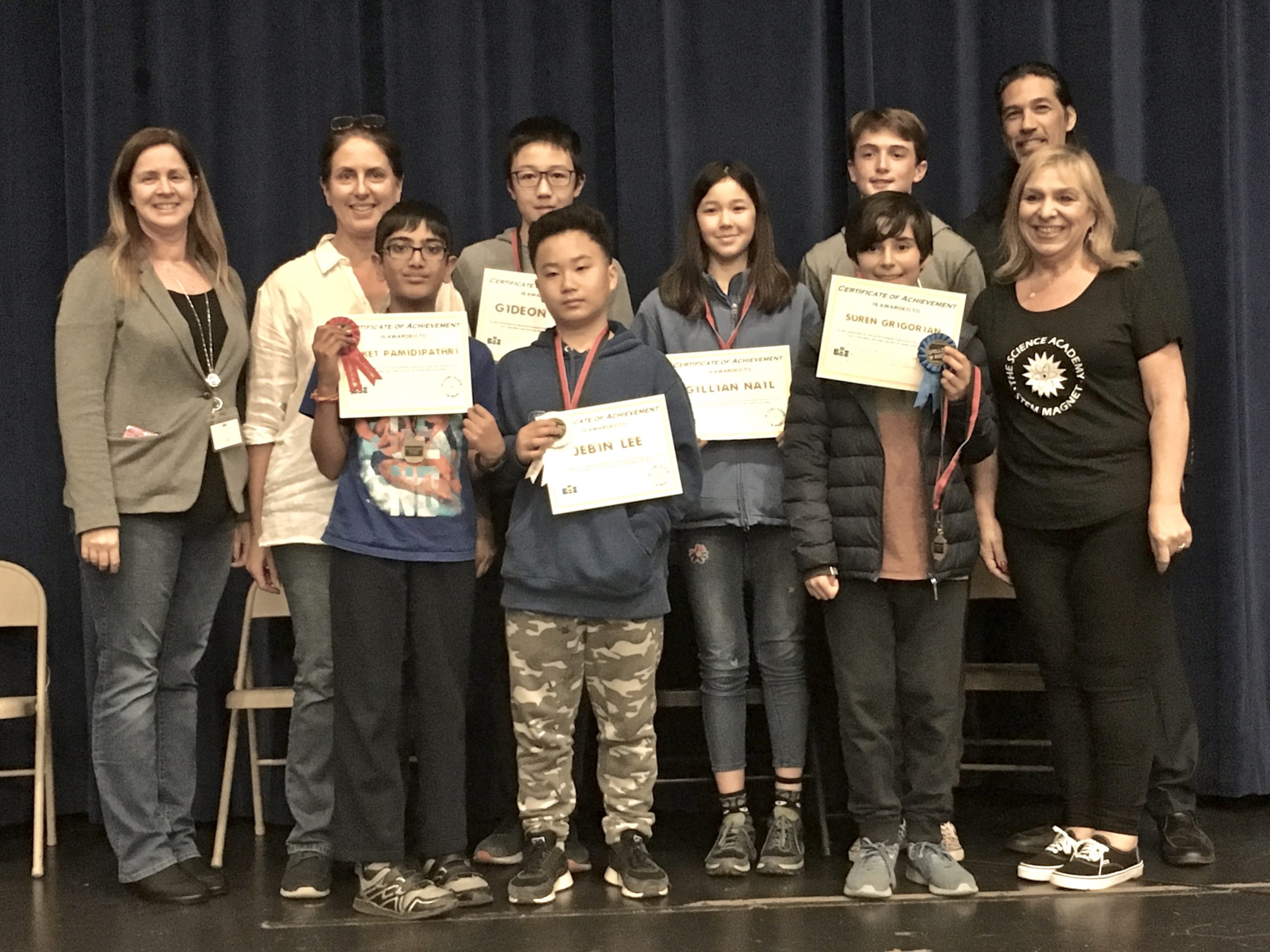

Let’s Leap!
By: John Lee and Payton Suh
The History of Leap Day
At first, the 355-day calendar was adapted by the Romans, and it worked fine for most purposes, but there was a dilemma. Yearly festivals were not occurring during their correct seasons. To solve this, a 22 or 23 day month was created every second year. Julius Caesar pondered on how to innovate on this concept, and so he added days to different months of the year to create the 365-day calendar. Caesar’s astronomer, Sosigenes, was the one who made the actual calculations to make this possible. Also, one day was to be added every fourth year following the 28th day of Februarius (February 29th), making every fourth year a leap year.
The Leap Day’s Astronomical Justification
This special day, February 29, was added to our calendar so that the calendar coincides with the Earth’s revolution around the sun. The earth spends 365.242 days to completely orbit around the sun. Calendars would be off about 24 days in 100 years had Leap Day not been implemented. Within the Gregorian calendar today, a Leap Day was added to the month of February within a year which is divisible by 400, allowing for additional accuracy within the anticipation of seasonal adjustments. This allows for the occurrence of Passover upon its proper date, as well as the correct placement of Easter, which is the first Sunday following the Paschal Moon.
Fun Facts about Leap Day
- One in five engaged couples in Greece will plan to avoid getting married in a leap year. They believe it is bad luck.
- People born on February 29 are called “leaplings” or “leapers”.
- More than 10,000 people worldwide are members of the Honor Society of Leap Year Babies. It is a club for people born on Feb. 29.
- Some astrologers believe that people born on February 29 have unusual talents.
- The only recorded person known to historians that have both been born and died on February 29 was Sir James Wilson (1812–1880).
- The chances of being born on leap day is 1 in 1500.
- Karin Henriksen of Norway gave birth to all three of her children on February 29 – a daughter in 1960 and two sons in 1964 and 1968.
- In Hong Kong, China, the legal birthday of a leapling is March 1 in common years, while in New Zealand it is February 28. If you timed it correctly, traveling from one of the countries to the other, you could technically enjoy the world’s longest birthday!
Happy Leap Day from the Science Academy News Flash!
Sources:
https://www.thoughtco.com/history-of-leap-year-1989846
https://www.gogreendrop.com/blog/making-the-most-out-of-leap-day/
Read More

